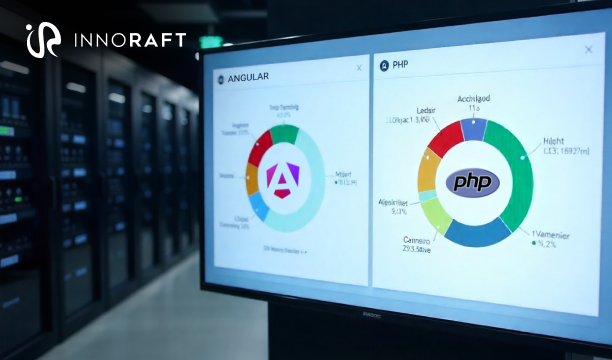When developing Angular apps with high data communications, one has to think of an end-to-end solution, covering data efficiency, network latency, scalability, resource handling, testing, and UX. Angular is great at creating compelling and interactive web apps for startups. However, as your application grows, it might become difficult to keep track of all that data governing its functionality. This is where state management comes in, providing a structured approach for keeping your Angular application manageable, scalable, and well-maintained.
One of the robust front-end frameworks, Angular, has multiple approaches to managing state effectively. In this blog post, let’s discuss Angular state management best practices to help you structure your application clearly and with intent.
What is Angular State Management and Why Does It Matter?
In web apps, "state" means an application's current state or data at any time. This might be anything from user input and API data to the current view a user is working with. Efficient handling of this state is essential, particularly as apps grow more sophisticated.
State management in Angular regulates data flow within an application, data storage, and UI modification based on state changes. State can be straightforward, where data is directly passed from one component to another in small apps, but as apps grow, it becomes harder to manage state. At that time, Angular state management methods kick in. With these methods, data is kept consistent, predictable, and accessible throughout various sections of an application.
Common Angular State Management Techniques

Component State
This is the basic approach to state management, where each component handles its data. Information is passed between components using Angular’s input and output bindings, making it straightforward for small applications.
Services and RxJS
Using Angular services allows for centralized state handling. Combined with RxJS, these services can efficiently manage asynchronous data streams, making them ideal for applications requiring real-time updates or shared data across multiple components.
NgRx
NgRx is a powerful state management library inspired by Redux tailored for Angular applications. It promotes a single, unidirectional data flow and uses a centralized store to manage application-wide state in a predictable and testable manner.
NGXS
NGXS is another widely used library that simplifies the Redux pattern with less boilerplate. It plays well with Angular's dependency injection and provides a developer-friendly mechanism for state management.
Akita
Akita is a newer state management solution designed for simplicity and flexibility. It helps developers manage state in Angular apps with minimal setup, avoiding much of the boilerplate typically associated with Redux-style patterns.
When to Use State Management in Angular Apps?
In smaller applications, state can often be managed with simple data binding or shared services. However, a more structured approach becomes necessary as the number of features increases and more components begin interacting with shared data.
Here are a few common use cases where implementing state management in Angular is beneficial:
When Your Application Gets More Complex
In the early stages, handling data directly within components might be easy. But as the app scales, things can quickly get messy. That's where structured Angular state management helps. It brings order to your code, keeps your data consistent, and ensures your app performs well, even as it gets more advanced.
What this helps with:
- Keeping things organized
- Ensuring data stays consistent
- Boosting app performance
- Improving the user experience
When You're Sharing Data Across Components
When numerous application components interact with the same data, regulating its flow is more difficult. Angular state management streamlines this process by centralizing all data, making sharing and maintaining consistency across the application easier.
What this helps with:
- Centralizing your data
- Making data sharing between components simpler and more reliable
When Your App Handles Asynchronous Tasks
If your app depends on tasks like API calls, real-time updates, or user interactions, managing state can get tricky. A good Angular state management setup keeps everything running smoothly by handling asynchronous data cleanly and predictably.
What this helps with:
- Keeping your async data flow organized
- Delivering a responsive, real-time UI
When You Need Predictable State Changes
The more complicated your application, the more data changes you need to manage. A quality state management system will allow you to keep track of those changes, so debugging and testing are much simpler.
What this helps with:
- Making state changes more predictable
- Simplifying testing and long-term maintenance
Best Practices for State Management in Angular
Efficient state management is fundamental to a scalable and easy-to-maintain Angular application architecture. Whether developing a small project or an expanding enterprise app, Angular state management best practices keep your code clean and your app responsive.
Centralized State for Large Applications
Centralizing state using libraries like NgRx, Akita, or Angular services combined with RxJS in complex applications is beneficial. A centralized approach to Angular state management simplifies debugging and gives you a clear picture of your app's data flow.
Use Immutable Data Structures
Maintain immutability when updating the state. This prevents unintended side effects, improves predictability, and plays nicely with Angular's change detection system.
Avoid Overusing Signals
While Angular signals are powerful, they aren't always necessary. For simple use cases, a component-level state or service may be more appropriate and easier to manage.
Leverage Selectors
Use selectors like @Input, @Output, and ngOnChanges to access state cleanly and efficiently. Selectors encapsulate the state's structure, keeping your component code tidy and more maintainable.
Use a State Management Library for Complex Apps
A state management library like NgRx or Akita can make a big difference in large-scale Angular applications with complex data interactions. These tools help manage state consistently and scale by introducing clear patterns such as actions, reducers, and effects.
Optimize for Better Performance
The poorly managed state can slow down your application. To keep things running smoothly, use Angular's ChangeDetectionStrategy.OnPush to minimize unnecessary change detection cycles.
Test Your State Logic
Write thorough tests for your state management logic—especially reducers, effects, and services—to catch bugs early and ensure stability as your app evolves.
Document Your Strategy
Maintain up-to-date documentation outlining your Angular state management approach. Include details on state structure, actions, reducers, and data flow for better team collaboration and onboarding.
Conclusion
State management in Angular is essential in creating a solid and maintainable application, particularly as your project becomes increasingly complex. Some fundamental techniques, like service-based state management, NgRx, and Akita, give developers several options for managing complex data and achieving consistency throughout the app. Understanding the choices for angular state management ensures that your application is responsive and organized as it expands. Angular is your go-to option if you need web development services to assist your business in making more efficient web applications.
To build flexible and scalable web and mobile applications, reach out to us and hire an Angular web developer.
FAQ
Frequently Asked Questions
Didn’t find what you were looking for here?




